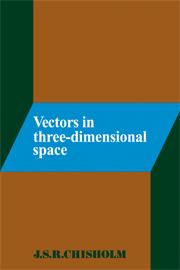Book contents
- Frontmatter
- Contents
- Preface
- 1 Linear spaces and displacements
- 2 Scalar products and components
- 3 Other products of vectors
- 4 Transformations of vectors
- 5 Curves and surfaces; vector calculus
- 6 Vector analysis
- Appendix A Some properties of functions of two variables
- Appendix B Proof of Stokes' theorem
- Reference list
- Outline solutions to selected problems
- Index
1 - Linear spaces and displacements
Published online by Cambridge University Press: 28 January 2010
- Frontmatter
- Contents
- Preface
- 1 Linear spaces and displacements
- 2 Scalar products and components
- 3 Other products of vectors
- 4 Transformations of vectors
- 5 Curves and surfaces; vector calculus
- 6 Vector analysis
- Appendix A Some properties of functions of two variables
- Appendix B Proof of Stokes' theorem
- Reference list
- Outline solutions to selected problems
- Index
Summary
Introduction
Our understanding of the physical world depends to a great extent on making more or less exact measurements of a variety of physical quantities. All single measurements on a physical system consist of observing a single real number, and very often this single real number is, by itself, the value of an important physical quantity; examples are the measurement of a mass, a length, an interval of time, an electrical potential, the frequency or wavelength of an electromagnetic wave, a quantity of electrical charge, and the electric current in a wire. Physical quantities of this kind are called scalar quantities, or, more frequently, scalars. We shall make a distinction between these two expressions: ‘scalar’ will be used as a mathematical expression; scalars, for our purposes, are real algebraic variables λ, μ, …, which can, in general, take values in the whole range (-∞, ∞); they possess other properties which will be defined in Chapter 4, but for the present we shall regard them simply as real numbers. The expression ‘scalar quantity’ will refer to any specific physically measurable quantity, such as a mass or a charge, which is found experimentally to have the mathematical properties of a scalar. One important property of scalar quantities is that they are intrinsic properties of a physical system, and do not change if the whole physical system is translated to a different position in three-dimensional space, or is rotated in space.
Information
- Type
- Chapter
- Information
- Vectors in Three-Dimensional Space , pp. 1 - 23Publisher: Cambridge University PressPrint publication year: 1978
